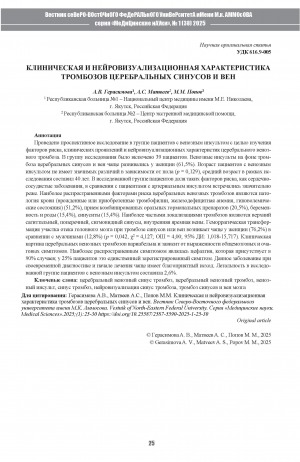Герасимова Анна Васильевна Документы 1 - 1 из 1
Количество страниц: 6 с.
Проведено проспективное исследование в группе пациентов с венозным инсультом с целью изучения факторов риска, клинических проявлений и нейровизуализационных характеристик церебрального венозного тромбоза. В группу исследования было включено 39 пациентов. Венозные инсульты на фоне тромбоза церебральных синусов и вен чаще развивались у женщин (61,5%). Возраст пациентов с венозным инсультом не имеет значимых различий в зависимости от пола (p = 0,129), средний возраст в рамках ис-следования составил 40 лет. В исследованной группе пациентов доля таких факторов риска, как сердечно-сосудистые заболевания, в сравнении с пациентами с артериальным инсультом встречались значительно реже. Наиболее распространенными факторами риска церебральных венозных тромбозов являются пато-логия крови (врожденные или приобретенные тромбофилии, железодефицитная анемия, гиповолемические состояния) (51,2%), прием комбинированных оральных гормональных препаратов (20,5%), беремен-ность и роды (15,4%), синуситы (15,4%). Наиболее частыми локализациями тромбозов являются верхний сагиттальный, поперечный, сигмовидный синусы, внутренняя яремная вены. Геморрагическая трансформация участка отека головного мозга при тромбозе синусов или вен возникает чаще у женщин (76,2%) в сравнении с мужчинами (12,8%) (p = 0,042, χ2 = 4,127; ОШ = 4,00; 95% ДИ: 1,018-15,717). Клиническая картина церебральных венозных тромбозов вариабельна и зависит от выраженности общемозговых и очаговых симптомов. Наиболее распространенным симптомом являлась цефалгия, которая присутствует в90% случаев; у 25% пациентов это единственный зарегистрированный симптом. Данное заболевание при своевременной диагностике и начале лечения чаще имеет благоприятный исход. Летальность в исследо-ванной группе пациентов с венозным инсультом составила 2,6%.
A prospective study was conducted in a group of patients with venous stroke to investigate the risk factors, clinical manifestations, and neuroimaging characteristics of cerebral venous thrombosis (CVT). The study covered 39 patients. Venous strokes due to thrombosis of cerebral sinuses and veins were more frequently observed in women (61.5%). There were no significant differences in the age of patients with venous stroke based on gender (p = 0.129), with a mean age of 40 years within the study cohort. In the investigated group, the prevalence of risk factors such as cardiovascular diseases was significantly lower compared to patients with arterial stroke. The most common risk factors for cerebral venous thrombosis included hematological disorders(congenital or acquired thrombophilias, iron deficiency anemia, hypovolemic states) (51.2%), the use of combinedoral hormonal contraceptives (20.5%), pregnancy and childbirth (15.4%), and sinusitis (15.4%). The mostfrequent sites of thrombosis were the superior sagittal sinus, transverse sinus, sigmoid sinus, and internal jugularveins. Hemorrhagic transformation of the brain edema at the site of sinus or venous thrombosis occurred more frequently in women (76.2%) compared to men (12.8%) (p = 0.042, χ2 = 4.127; OR = 4.00; 95% CI: 1.018-15.717). The clinical picture of cerebral venous thrombosis is variable and depends on the severity of generalized and focal symptoms. The most common symptom reported was cephalalgia, present in 90% of the cases; in 25% of the patients, it was the only registered symptom. This condition has a favorable outcome with timely diagnosis and initiation of treatment. The mortality rate in the studied group of the patients with venousstroke was 2.6%.
A prospective study was conducted in a group of patients with venous stroke to investigate the risk factors, clinical manifestations, and neuroimaging characteristics of cerebral venous thrombosis (CVT). The study covered 39 patients. Venous strokes due to thrombosis of cerebral sinuses and veins were more frequently observed in women (61.5%). There were no significant differences in the age of patients with venous stroke based on gender (p = 0.129), with a mean age of 40 years within the study cohort. In the investigated group, the prevalence of risk factors such as cardiovascular diseases was significantly lower compared to patients with arterial stroke. The most common risk factors for cerebral venous thrombosis included hematological disorders(congenital or acquired thrombophilias, iron deficiency anemia, hypovolemic states) (51.2%), the use of combinedoral hormonal contraceptives (20.5%), pregnancy and childbirth (15.4%), and sinusitis (15.4%). The mostfrequent sites of thrombosis were the superior sagittal sinus, transverse sinus, sigmoid sinus, and internal jugularveins. Hemorrhagic transformation of the brain edema at the site of sinus or venous thrombosis occurred more frequently in women (76.2%) compared to men (12.8%) (p = 0.042, χ2 = 4.127; OR = 4.00; 95% CI: 1.018-15.717). The clinical picture of cerebral venous thrombosis is variable and depends on the severity of generalized and focal symptoms. The most common symptom reported was cephalalgia, present in 90% of the cases; in 25% of the patients, it was the only registered symptom. This condition has a favorable outcome with timely diagnosis and initiation of treatment. The mortality rate in the studied group of the patients with venousstroke was 2.6%.
Герасимова, А. В. Клиническая и нейровизуализационная характеристика тромбозов церебральных синусов ивен / А. В. Герасимова, А. С. Матвеев, М. М. Попов ; Республиканская больница N 1 – Национальный центр медицины им. М. Е. Николаева, Республиканская больница N 2 - Центр экстренной медицинской помощи" // Вестник Северо-Восточного федерального университета им. М. К. Аммосова. Серия "Медицинские науки". - 2025. - N 1 (38). - C. 25-30. - DOI: 10.25587/2587-5590-2025-1-25-30
DOI: 10.25587/2587-5590-2025-1-25-30
